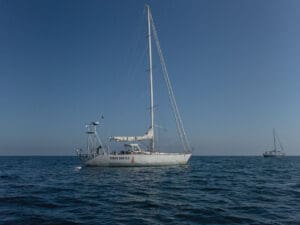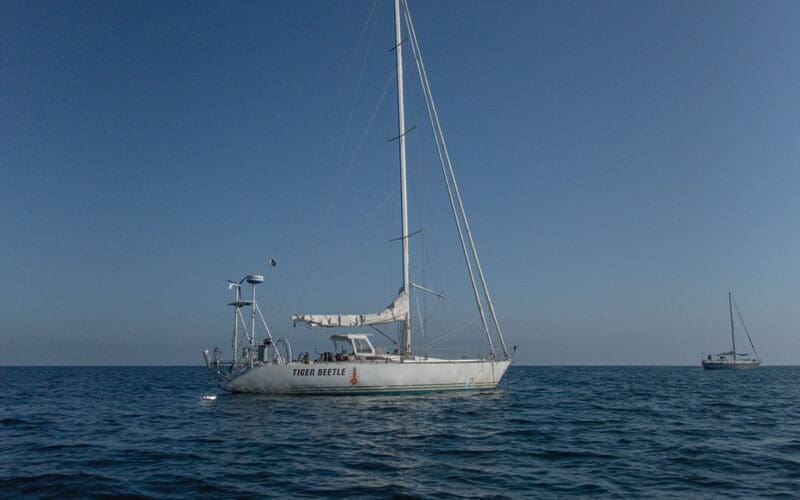By Rob MacFarlane
 When out cruising on my Morgan 45 Tiger Beetle, I anchor out rather a lot, so I become a good friend with my windlass for managing the ground tackle. A big enough boat will likely require ground tackle too heavy to lift by hand, and an all-chain rode will make it impossible raise — unless you can dead-lift that much weight. Enter the windlass, an enormously powerful geared-down motor-driven gypsy and capstan.
When out cruising on my Morgan 45 Tiger Beetle, I anchor out rather a lot, so I become a good friend with my windlass for managing the ground tackle. A big enough boat will likely require ground tackle too heavy to lift by hand, and an all-chain rode will make it impossible raise — unless you can dead-lift that much weight. Enter the windlass, an enormously powerful geared-down motor-driven gypsy and capstan.
I installed a vertical Maxwell windlass mounted horizontally in Beetle’s anchor locker; consultation with Maxwell established that there were two orientations of the gear box that work in that configuration and I could keep the deck clear. That windlass has done yeoman’s duty onboard, lowering and lifting the anchor and 225-feet of chain rode (there’s an additional 300-feet of 5/8-inch three strand nylon attached to the chain for anchoring in extra-deep water). While the unit is strong and well-built, it does require maintenance and care during use.
Here are some details on installation, setup, and use.
Install a chain stopper. The chain stopper is critical for preserving the windlass drive shaft on an all-chain rode; the chain stopper’s role is to capture the chain’s load if the chain should go bar tight before that load transfers to the windlass. If there’s no chain stopper in the system then all loads created by the ground tackle are directly transferred to the windlass, and you can bend the drive shaft.
Set the clutch slip point. To minimize unexpected loading on the drive shaft set the clutch cone slip to be just slightly more than the weight of the chain and anchor suspended in the water column. A simple way to set the clutch is go out to deep water and run out the anchor and all rode out such that everything is hanging straight down in the water column. With everything out, run the windlass to lift all that weight and ease the clutch until it slips, then tighten up the clutch just enough to do the lift. Then I run everything out again and verify the windlass will lift everything as desired. The goal is to have the clutch slip before damaging the windlass. The chain stopper and clutch work together to avoid overloading the windlass when the bow lifts on a swell or wave when retrieving the anchor: the clutch slips the load, the chain stopper holds the load.
Lower the anchor slowly. I do not like to release the windlass clutch and drop a bunch of chain in an uncontrolled manner. I’d like to avoid issues due to tangled or hockled chain inside the anchor locker jamming against the hawse pipe or deck. Instead I lower the anchor slowly and controllably to provide time to react to and sort out any rode issues if they crop up, though this does mean making allowance for the boat’s drift as the anchor descends to the bottom.
Use a bridle. Usually the anchor platform and bow roller are designed to support the weight of the anchor and rode while lifting, but will not carry the load while at anchor. A bridle transfers the anchor’s holding load to deck cleats.
Avoid slamming the anchor home. After raising the ground tackle don’t use the windlass to slam the anchor into the roller, as this creates a shock load that can crack or break the metal key(s) connecting the drive shaft to the gear box. It’s better to get the anchor just about in place, and then use a rope to snug the anchor up tight and stowed in the roller.
Use a secondary line. Avoid depending upon the windlass to keep the anchor in stowed position on the bow roller, instead use a secondary line to tension and secure the anchor. Also consider avoiding metal parts to keep the anchor in place, particularly the often-seen horizontal metal pin passed through the roller and anchor; if that pin bends then it can be difficult to quickly release the anchor if you had to. Using a rope lashing means the anchor can be deployed simply by cutting the line, usually much quicker than attempting to hammer out a bent pin.
Maintenance is fairly simple — keep the drive shaft lubricated with grease, verify the oil level in the gear box is correct, and keep the chain gypsy clean. If the drive motor is hydraulic, inspect the hydraulic lines and connections for leaks, and keep an eye on how clean (or not) the hydraulic fluid is. Beetle’s windlass uses a 12vDC electrically-driven motor, so I check the wiring for corrosion and keep connections clean.
Then there’s bridles, chain hooks, chafe, chain hooks, and deck cleats. A friend and I both had the dubious enjoyment of riding out a Low pressure front in French Polynesia, which resulted in four-foot chop driven across the miles of fetch within the atoll. With the boats’ bows plunging up and down in the chop, at times immersing the bow pulpit, the loads were sufficient to bend his chain hook that connected the bridle to the chain rode. The bent chain hook no longer could hold onto the chain, and it was not easy or particularly safe for him when he crawled out on the anchor platform to reattach the bridle with a rolling hitch.
I’ve always used a rolling hitch to attach the bridle to the chain, so I didn’t have to worry about it releasing the chain. Tying and untying the bridle takes more time than a chain hook, but I’ve not had that attachment method fail or slip, and there’s nothing to bend and stop working. Sometimes simple methods aren’t such a bad thing. What happened to me is the nylon bridle line cut through the port side chafe guard (old fire hose over thick wall flexible hose) and proceeded to wear through several layers of fiberglass at the hull-to-deck joint. I have since installed wrap-around stainless steel plates at the deck cleats to better protect the hull.
A boat further up the atoll did not fair so well. They were on an all-chain rode, their bridle broke and they didn’t notice, the chain now pulled directly against the bow roller, which in turn broke off, and the chain sawed its way down through the hull and opened up the anchor locker. All the damage remained above the water line so they didn’t sink, but it was a significant repair. So keep an eye and ear out on what’s happening at the bow when conditions warrant.
Rob MacFarlane has raced and cruised as a singlehander for 30 years on San Francisco Bay, the West Coast, Hawaii, Mexico, Canada and French Polynesia.

